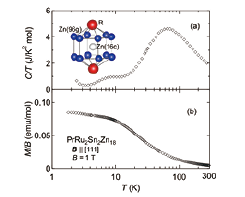Structural, Magnetic, and Transport Properties of Novel Quaternary Compounds RRu2Sn2Zn18 (R = La, Pr, and Nd)
K. Wakiya, I. Umehara, and Y. Uwatoko
Cubic Pr-based intermetallic compounds are expected to show various fascinating phenomena arising from multipole degrees of freedom, when the crystal electric field (CEF) ground state of Pr3+ ion is the non-Kramers Γ3 doublet. This is because the Γ3 doublet possesses not a magnetic dipole but electric quadrupoles and a magnetic octupole. Recently, PrT2X20 (T: Transition metal, X = Zn, Al) with the non-Kramers doublet ground state have attracted much attention because they exhibit a coexistence of superconductivity with quadrupole ordering [1-4]. In addition, they exhibit a non-fermi liquid behavior in the electrical resistivity and specific heat [1-4]. It is theoretically suggested that the non-Fermi liquid behavior is caused by the hybridization of quadrupoles with conduction electrons [5]. However, in order to increase our understanding of these phenomena, it is still crucial to find a new Pr compound with the Γ3 doublet ground state because the number of such compound is limited.

Fig. 1. (a) specific heat divided by temperature C/T and (b) magnetic susceptibility χ (= M/B)of PrRu2Sn2Zn18. The inset of (a) shows the Pr2Zn12 cage surrounding the Zn atom at the 16c site [Zn(16c)]. In PrRu2Sn2Zn18, Zn atoms at the 16c site are fully replaced by Sn atoms.
We recently focused on the isostructural compound PrRu2Zn20 which shows a structural transition at TS = 138 K [6]. PrRu2Zn20 shows no quadrupole ordering because the CEF ground state doublet is split into two singlets as a result of the site symmetry lowering at the structural transition. In PrT2Zn20, there are three distinct Zn sites: 16c, 48f, and 96g. Among these, Zn atoms at the 16c site [Zn(16c)] is encapsulated by an R2Zn12 cage as shown in the inset of Fig. 1(a). A first principles calculation suggested that the large cage space of R2Zn12 cage induces the structural transition [7]. For RT2X20 (R: Rare earth, T: Transition metal, X = Zn, Al), the cage space is evaluated by subtracting the atomic radius of the caged atom from the average distance between the atoms forming the cage and the caged atom [8]. Recently, in isostructural RT2Zn20 (R = La-Nd, T = Co and Fe), it was reported that Zn(16c) can be fully replaced by the Sn atom [9]. This suggests that the structural transition in PrRu2Zn20 can be suppressed by the Sn substitution because the cage space of the Pr2Zn12 cage is reduced by introducing the Sn atom with a larger atomic radius into the 16c site. In this study, we synthesized Sn-substituted PrRu2Zn20 using self-flux and melt growth methods in order to obtain a new cubic Pr-based compound.
The single-crystal x-ray structural analysis for obtained samples revealed that the Sn atoms selectively occupy the 16c site. Thus, the chemical formula of the obtained sample can be described as PrRu2Sn2Zn18. Figure 1(a) shows the specific heat divided by temperature, C/T, of PrRu2Sn2Zn18. No anomaly due to a structural transition is observed in C/T, suggesting that PrRu2Sn2Zn18 remains cubic even at low temperatures. A broad peak at around 8 K is probably attributed to a Schottky peak due to the CEF splitting. Below 3 K, C/T increases with decreasing temperature, implying that the magnetic entropy is released even below 3 K. Figure 1 (b) shows the magnetic susceptibility χ of PrRu2Sn2Zn18. Below 10 K, χ shows a Van-Vleck paramagnetic behavior, indicating that the CEF ground state of PrRu2Sn2Zn18 is non-magnetic. Since the Pr site has cubic symmetry, the J multiplet of Pr ion with a total angular momentum of J = 4 split into four multiplets; nonmagnetic Γ1 singlet and Γ3 doublet, and magnetic Γ4 and Γ5 triplets. Considering that the magnetic entropy is released even below 3 K, the CEF ground state of PrRu2Sn2Zn18 should be a nonmagnetic Γ3 doublet.
In conclusion, we have grown a new quaternary compound PrRu2Sn2Zn18. The structural transition in PrRu2Zn20 can be suppressed by the Sn substitution. The magnetization and specific heat measurements revealed that the CEF ground state of PrRu2Sn2Zn18 is probably a Γ3 doublet. Therefore, PrRu2Sn2Zn18 is a promising material for studying the exotic phenomena arising from the multipole degrees of freedom.
References
- [1] T. Onimaru et al., Phys. Rev. Lett. 106, 177001 (2011).
- [2] A. Sakai et al., J. Phys. Soc. Jpn. 81, 083702 (2011).
- [3] K. Matsubayashi et al., Phys. Rev. Lett. 109, 187004 (2012).
- [4] M. Tsujimoto et al., Phys. Rev. Lett. 113, 267001 (2014).
- [5] A. Tsuruta and K. Miyake, J. Phys. Soc. Jpn. 84, 114714 (2015).
- [6] T. Onimaru et al., J. Phys. Soc. Jpn. 79, 033704 (2010).
- [7] T. Hasegawa et al., J. Phys. Conf. Ser. 391, 012016 (2012).
- [8] Z. Hiroi et al., J. Phys. Soc. Jpn. 81, 124707 (2012).
- [9] Y. Isikawa et al., J. Phys. Soc. Jpn. 84, 074707 (2015).
